Charlize Theron Bombshell
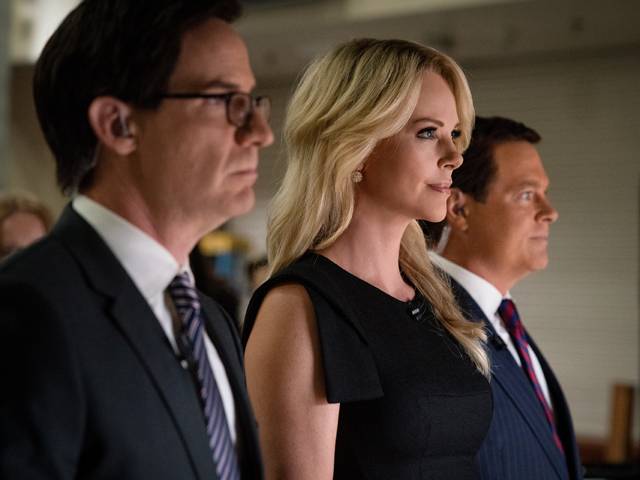
Based On A Real Scandal
Cast: Nicole Kidman, Allison Janney, Mark Duplass, Margot Robbie, Charlize Theron, Connie Britton, John Lithgow, Malcolm McDowell , Rob Delaney
Director: Jay Roach
Genre: Biography, Drama
Rated: M
Running Time: 109 minutes
Synopsis: Starring Academy Award® winner Charlize Theron, Academy Award® winner Nicole Kidman, Academy Award® nominee Margot Robbie and Academy Award® nominee John Lithgow, based on the real scandal, Bombshell is a revealing look inside the most powerful and controversial media empire of all time; and the explosive story of the women who brought down the infamous man who created it.
Bombshell
Release Date: January 16th, 2020
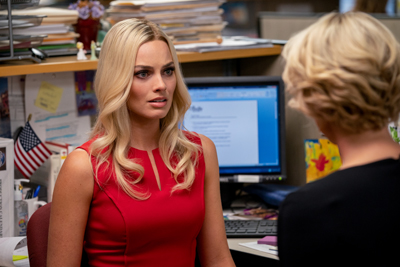 About The Production
About The Production
Based on the real scandal, Bombshell tells the explosive story of the women who brought down the man who helped create the most powerful and controversial media empire of all time, Fox News. But at heart of the film is also an exhilarating portrait of how courage is forged in the moment, as three very different women resolve to fight back against unchecked power and abuse.
No one saw it coming. Not a soul could have predicted that one of the first strikes in the catalytic movement to overturn the long history of workplace harassment would come from inside the least likely place: at the core of deeply conservative, profoundly loyalist Fox News. Yet, as the world would soon come to see, this was not an issue of right, left or center, but of righting a legacy of wrongs.
The fuse was boldly lit in the summer of 2016 by Gretchen Carlson, once the unswervingly perky co-host of influential "Fox & Friends." When the recently fired Carlson slapped Fox News' founder Roger Ailes with a lawsuit alleging sexual harassment, most expected Carlson to get crushed. After all, Ailes was the untouchable master of the media universe"ready to use his influence and resources to defeat any foe. Instead, what happened next reverberated around the world.
But it was never just about the women at Fox. What happened in those two weeks"as Gretchen Carlson, Megyn Kelly and the women of Fox rang the alarm bells of cultural change"became a harbinger of a defining moment of our era. Just over a year later, in October 2017, the New York Times would report multiple accusations against entertainment titan Harvey Weinstein, a story that would then combust, growing the small, pre-existing #MeToo movement into a massive global phenomenon. By then, it was clear the corporate codes of silence were being detonated across every industry.
This deeper cultural significance is what most intrigued Bombshell's three producers: Emmy®-winning director Jay Roach (Game Change, Outstanding Directing"Limited Series/Movie, 2008; All The Way, Trumbo), who also directs; Oscar® winner Charles Randolph (The Big Short, Best Writing (Adapted Screenplay), 2015), who wrote the screenplay; and Oscar® winner Charlize Theron (Monster, Best Actress, 2003), who also plays Megyn Kelly.
Roach, Randolph and Theron set out to create a film that, while cognizant of our divided world, never lets politics overshadow what the story is really about. Theron explains: "This is a story about people's rights being violated, and that's not partisan. The bottom line is that we should all be free to be ambitious, to pursue the things we believe in and to do our jobs in a safe environment. You can have a healthy debate about the right way to go about the news business. But no one should ever be in a position where you feel that your ultimate goals will be taken away from you if you speak the truth about someone in power. That just shouldn't happen. To anybody."
The decision to play Kelly was a weighty one for Theron, who struggled to get past some of Megyn's more controversial aspects. She ultimately came to terms with the need to bring this story to the forefront in spite of those concerns saying, "When you can see the power of a message even through the eyes of someone you don't agree with"even someone who might anger you at times"that tells you there's something very real and very important there."
Theron is joined by the talents of three other Academy Award® winning and nominated performers who each bring instantly recognizable, larger-than-life characters to emotionally complex life: Academy Award® winner Nicole Kidman (The Hours, Best Actress, 2002) as Gretchen Carlson; Academy Award® nominee John Lithgow (Terms of Endearment, Best Supporting Actor, 1983) as Roger Ailes; and Academy Award® nominee Margot Robbie (I, Tonya, Best Actress, 2017) as fictional Kayla Pospisil.
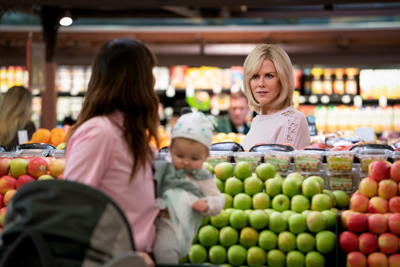 They lead an incredible ensemble cast who bring out a wide range of human shadings in characters who represent many points of view, including Allison Janney, Malcolm McDowell, Kate McKinnon, Connie Britton, Liv Hewson, Brigette Lundy-Paine, Rob Delaney, Mark Duplass, Stephen Root, Nazanin Boniadi, Alanna Ubach, Bree Condon, Brooke Smith, Michael Buie, Ashley Greene, Elisabeth Röhm, Alice Eve, and Spencer Garrett.
They lead an incredible ensemble cast who bring out a wide range of human shadings in characters who represent many points of view, including Allison Janney, Malcolm McDowell, Kate McKinnon, Connie Britton, Liv Hewson, Brigette Lundy-Paine, Rob Delaney, Mark Duplass, Stephen Root, Nazanin Boniadi, Alanna Ubach, Bree Condon, Brooke Smith, Michael Buie, Ashley Greene, Elisabeth Röhm, Alice Eve, and Spencer Garrett. Immersing audiences into the revealing Fox News world is a behind-the-scenes team led by Oscar®- nominated director of photography Barry Ackroyd BSC (The Hurt Locker, Best Cinematography, 2009; The Big Short, Captain Phillips), known for his kinetic, in-the-moment shooting style, as well as production designer Mark Ricker (Trumbo, The Help), editor Jon Poll (The Greatest Showman), four-time Oscar®- winning costume designer Colleen Atwood (including Fantastic Beasts and Where to Find Them, 2016; Alice in Wonderland, 2010) and composer Theodore Shapiro (Last Christmas). Oscar®-winning makeup designer Kazu Hiro (Darkest Hour, Best Makeup and Hairstyling, 2017) also made a unique contribution helping to sculpt celebrity faces with prosthetics that, while uncanny, also allow the full weight of the actors' emotions to shine through.
The Opening Volley: How Bombshell Began
The minute Charlize Theron finished reading Charles Randolph's script for Bombshell, she could not wait to produce it. Just as Randolph had shattered the mold of the current affairs movie with The Big Short, Theron saw him doing it all over again, turning another slippery, challenging but absolutely watershed moment of our times into an intense and incisive human drama.
"Coming to the film as a producer was really a no-brainer," says Theron. "Charles's script was just spectacular. The research he did was phenomenal, and he took such a broad view on how change is created. We were expecting something great and it surpassed all our expectations. On top of that, I was just totally moved that a man had written this story, because it proves this is a subject for all people." Likewise, though set in the belly of partisan TV, the story wasn't about politics. Instead, it insisted on being about something deeper: how very different kinds of people can choose to stand up against powers that seem greater than themselves. Theron has always been drawn to films with tricky characters and complicated situations. In 2005, she starred in North Country, the story of the very first major sexual harassment case in the U.S. But the story of how the Fox News women took down their seemingly invincible boss went even further. It showed how three hugely competitive women ultimately upended the attempt to pit them against one another and instead turned against the power structure itself.
Also impressive to Theron was just how true Randolph's depiction was of what the women at Fox went through"the exhausting process of constantly trying to deflect, or develop entire personal strategies for handling day-to-day adversities when you're in an abusive situation. Yes, the story took place in the heightened pressure cooker of a newsroom"and reverberated with reflections on the whole idea of public image and media power"but it took aim at a bigger phenomenon. It was at its core, Theron felt, about that take-charge moment when a group of women found the freedom, whatever the results, to say "enough."
"What felt important was to go back to the story of these women who actually catapulted us into this movement that continues to grow," Theron says. "This was one of the first workplace harassment suits of its kind. It was over a year before the Harvey Weinstein story broke, so it was truly the precursor. And Charles had brought it all to life as a story that lets you get angry, that gets emotional, but that also lets you laugh at the absurdity. I saw in it a human story that was really complex and well-rounded."
Much as she was keen to help shepherd the project, Theron was torn about the possibility of playing Megyn Kelly. Her struggle with the decision inspired her to send the script to her good friend Jay Roach, at first just angling for nothing more than his always-welcome insights.
Roach was also an immediate fan of the script. In fact, he couldn't help but envision it coming to life" with Theron as Kelly. Though Roach knows well there's a distance between the way Kelly and Theron see the world, he also felt that this could push Theron into exciting territory, as she explored Kelly's internal drives and contradictions. Recalls Roach: "I said to Charlize, 'I know it's probably not the first thing on your mind to portray Megyn Kelly, and you probably don't agree on very much with her. But this is such a powerful story with a chance to reach a broad audience. I just knew she'd be great because Charlize always rises to the most complex challenges."
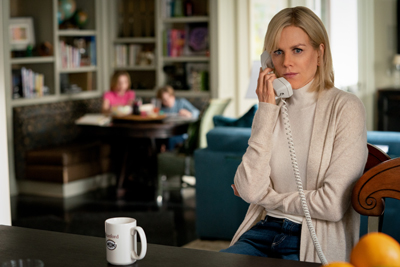 Theron then turned the tables. "She said, 'I'll do it, but only if you direct it,'" Roach remembers.
Theron then turned the tables. "She said, 'I'll do it, but only if you direct it,'" Roach remembers. Theron's commitment to working on both sides of the camera quick-started the production. "Charlize was truly the most profound creative force on Bombshell," Randolph says. "She was vital in getting it to the screen. And even as she was giving such a great performance, she was a very hands-on producer, delivering notes on every scene."
When Randolph began drafting the screenplay, he couldn't have known such a massive cultural sea change was at hand. And yet, he recalls that he increasingly sensed something boiling under the surface. He kept hearing from female friends about the systematic sexual pressure and even assault they experienced at work, including in the news business. Then, in 2016, Randolph learned about how Ailes plummeted from a veritable kingmaker to resigning in disgrace from the network he helped to build.
If this was happening at the heart of Fox News, Randolph reasoned, then it was potentially happening in other places too, and he suspected it was a sign of things to come.
Randolph was inspired to dig deeper"and also to rethink how to tell this kind of story. "I felt this was a story that not only needed to be told for women, but also for men," Randolph explains. "I thought, if I can put male audiences inside the subjective experience of harassment and what that means and how it feels, that's what I really would like to do in a film. Women will recognize these experiences, but men may encounter something they hadn't realised."
To learn more about what spurred the women's decisions to take the leap, Randolph embarked on a research operation. He sat down with a stream women to get their first-hand accounts of sexual harassment in the workplace. These very personal and individual experiences helped to significantly inform the screenplay. "I was interested in finding a way to glean something more morally complex than what you saw in the news, something funnier at times and also sadder at times. I was looking for the larger truths."
Those larger truths resonated with Roach. Drawn to the places where political events and human revelations cross, Roach is best known for a string of deftly researched projects based on real-life incidents, including HBO's Emmy®-winning Recount about the 2000 presidential election, and Game Change about the 2008 McCain/Palin campaign. Still, taking his cues from Randolph's screenplay, he felt this film demanded a stylistic approach that might break down walls and perceptions"that might invite audiences to engage with life inside the Fox News world in ways they maybe never anticipated, regardless of how where they came down on the network's slant on the news.
Roach also spent a lot of time thinking especially about what approach he should take as a man addressing a story in part about three women tapping fully into their agency. "I have a real interest in issues of gender equality, but I can't even begin to pretend to imagine what it's like to go through the things working women go through," Roach openly admits. "But the thing that convinced me that I could do this is not only that Charlize was asking me to do it and trusted me to do it. It was also this idea that when it comes to changing things, men really have to start talking more to other men. There aren't enough men right now asking all the hard questions about this issue."
Like Randolph, Roach dove into his own intensive bout of research, much of it also first-hand. I watched hours and hours of footage, read many books, but especially I did my own interviews with people about their personal experiences," says Roach. "I get so much out of talking to real people."
As development of the project deepened, Roach, Randolph and Theron conversed at length about tone. As he had in The Big Short, Randolph had taken a lot of creative storytelling risks - from utilizing six women narrators whose explanatory voiceovers serve as the connective tissue of the story to bursting through the fourth wall to address the audience. But Roach also knew he had to walk a tightrope. "It's not a film that's preachy, but it's about something hugely consequential. There's a lot of humor in Charles's writing, but the characters are going through crucial dilemmas. I really wanted to connect to the spirit of the writing and find that balance," he explains.
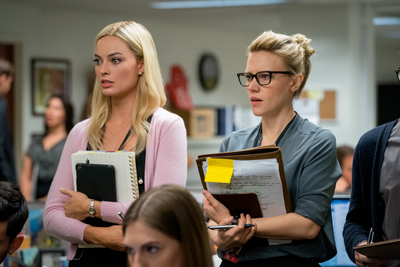 Roach, Randolph and Theron all agreed that one of the things that had made the script so exhilarating was that it avoids a singular point-of-view. Instead, it mirrors the chaotic, often clashing, mix of personal motives and decisions that are the least-talked-about part of social change. Each of the main characters starts in a different place from the others and wrestles very personally with the perils of speaking out. "Megyn is the film's narrative center," Randolph describes. "She is our Dante, who takes us deep into this world. Gretchen is the moral center in that she frames the issue and makes the most heroic choice. And Kayla is the emotional center of our story"someone we identify with as she experiences harassment.
Roach, Randolph and Theron all agreed that one of the things that had made the script so exhilarating was that it avoids a singular point-of-view. Instead, it mirrors the chaotic, often clashing, mix of personal motives and decisions that are the least-talked-about part of social change. Each of the main characters starts in a different place from the others and wrestles very personally with the perils of speaking out. "Megyn is the film's narrative center," Randolph describes. "She is our Dante, who takes us deep into this world. Gretchen is the moral center in that she frames the issue and makes the most heroic choice. And Kayla is the emotional center of our story"someone we identify with as she experiences harassment. Kayla's is the story we least often hear: the story of the woman who gives in to a harasser, and what that means to her life. I didn't want to put that burden on a real person, so I made that character fictional."
Also important to the filmmakers was taking the opportunity to examine just how many strikingly different forms of harassment exist, from the casual to the criminal. "We address about two dozen different types, from an unwanted backrub to a face-to-face proposition of 'you'll get this job if you do this,'" Randolph notes.
On set, this led to some intense moments, as the filmmakers tried to cultivate a safe place for volatile emotions. One scene that hit especially hard was when Margot Robbie as Kayla "auditions" for John Lithgow as Roger Ailes, in what becomes an alarmingly sexualized encounter based on real-life stories about Ailes's infamous insistence that his on-camera talent twirl before him.
Recalls Roach: "Unusually, I was a camera operator in that scene and there was something about watching it through the lens that made it even more empathetic, I was shaking with emotion, because I just could feel what these characters were going through."
Later, while editing, Roach found a singular shot that makes the scene work without needing to become explicit. "It was all about that tilt up and reveal that Kayla is just as horrified by this moment as you are," he says. "In that moment, Margot reveals all the horror, the humiliation and off balanced confusion that Kayla feels. It's one of the most powerful moments I've experienced in a film."
Moments like that are why Theron is extremely grateful that she and Roach connected in that first call. "I can't imagine now having made this film with anybody else," she says. "Jay can tell a complicated story in way that you feel transported into the room with these people. That's an incredibly powerful gift."
Theron On Kelly
In the summer of 2016, the star rising at the speed of light at Fox News was Megyn Kelly, host of the highly rated nightly news show "The Kelly File." Fiery, confrontational, charismatic and unabashedly opinionated no matter the backlash, the former prosecutor was becoming a rare mainstream breakout.
Even in the wake of controversies, Kelly would attain cultural heroine status after she confronted thencandidate Donald Trump about his treatment of women during the Republican debates. When it came to Roger Ailes, Kelly had successfully rebuffed his advances. Yet when Gretchen Carlson's lawsuit against Ailes kicked off an internal investigation, it was clear that Kelly had a choice to make. She chose not to duck, and not to defend her boss, but to go public about her harassment experiences with Ailes.
In Bomshell Kelly is a linchpin, the one person who can most draw the spotlight, even if she might get caught in the glare. Theron brings her penchant for disappearing into characters"from a serial murderer on death row in Monster to the fantastical warrior Furiosa in the iconic action thriller Mad Max: Fury Road"to the role.
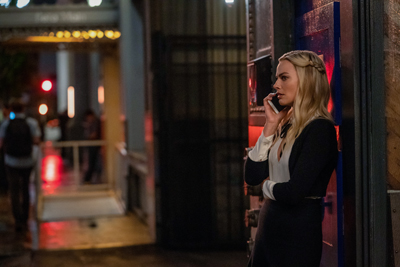 Well before she got to the set, Theron began plunging herself into Kelly's persona, even listening to recordings in the car while driving. She poured through endless interviews and worked intensively with a dialogue coach. "I wanted to do all the research, all the voice work, thinking and processing, so I could then throw it all out the window and just be Megyn in the moment," Theron explains.
Well before she got to the set, Theron began plunging herself into Kelly's persona, even listening to recordings in the car while driving. She poured through endless interviews and worked intensively with a dialogue coach. "I wanted to do all the research, all the voice work, thinking and processing, so I could then throw it all out the window and just be Megyn in the moment," Theron explains. Though he expected a lot, Roach was awed by how all-in Theron was, ready to fully take on not only Kelly's candy-colored stretch dresses but her deep-timbred voice and entire physical presence. "Charlize devoted herself 110% to connecting with Megyn. She gave up many, many hours of sleep to get to the set early and endure prosthetics application every day. Early on, I said to her, 'Charlize, you don't really need to do anything. You can evoke Megyn with pure performance.' But she said, 'I need to see myself in the mirror and not recognize myself. I need this voice to be coming out of Megyn Kelly's face.' Charlize has incredible craft, but she doesn't think about craft. She comes at the role thinking about truth."
What intrigued Theron most is that Kelly could have kept quiet and prospered but dared to come forward. "She was the superstar at Fox in the process of renegotiating her contract. She had everything going for her," Theron says. "It was very complicated for her, which is something we don't talk enough about"that women's choices in these circumstances are never easy; they're complicated and personal."
Theron notes that Kelly was always torn in her loyalties. "She was incredibly conflicted about how much she liked Roger Ailes, even though he was abusive to her. And that's another thing I hope we will talk more about. "We have to start talking about the truth of what predators look like, and that there can be a level of real seduction. Women feel a lot of shame to admit they sometimes liked their abuser even though they just wanted the abuse to stop."
Despite sharing so little in common with Kelly on so many issues, Theron says that this never really became a barrier to feeling passionate about telling this story, always a prerequisite for her. "Megyn was an important part of what has become an important moment in history. That doesn't cancel out everything else she has said or done, or how I feel about those things," Theron says with her typical honesty, "but in making the decision she did, she was part of something remarkable."
That passion kept Theron motivated during the rigorous daily makeup to subtly shift her into Kelly's squarejawed profile. Special makeup designer Kazu Hiro, who Theron brought aboard to design all the film's prosthetics, notes: "Charlize spent about 3 hours every day in makeup chair, and she did it because she was so committed to becoming this character completely."
Kidman On Carlson
Academy Award® winner and five-time Golden Globe® winner Nicole Kidman has shown her immense versatility in roles from a conniving newscaster in To Die For to the literary heroine Virginia Woolf in The Hours, a cabaret star in Moulin Rouge, a mother whose children are being haunted in The Others, an adoptive mother whose son wants to search for his birth family in Lion, an abused wife inthe runaway HBO hit "Big Little Lies" and Queen Atlanna in Aquaman, to name just a few.
She takes another entirely fresh turn as Gretchen Carlson, the Minnesota-born, former Miss America-turned popular Fox News host, who shocked the world by suddenly daring to confront Roger Ailes and take a bold stand for women. Kidman brings a compellingly human edge to Carlson as she takes a driving satisfaction from turning Ailes's own game against him.
"Nicole's interpretation of Gretchen is fascinating," Randolph says. "It really leans into Gretchen's beauty-pageant-winner need for approval, mixed in with her Midwestern confidence. Her character is constantly self-motivating – she's convinced you just have keep pulling yourself up by the bootstraps."
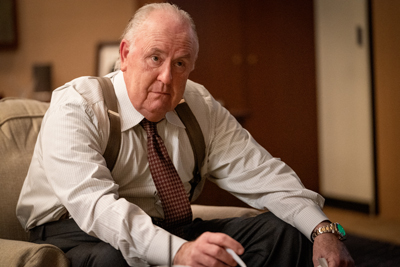 Like Theron, Kidman came to the project with many ideas and a deep commitment to capturing the essence of Carlson, despite not having a chance to consult directly with her in preparing for the role, since Carlson's settlement with Fox News prohibited it. Recalls Roach: "Nicole had very specific suggestions, especially about connecting to Gretchen as a mother. She wanted scenes that showed she had a family to support and how much she cared about that. We also talked about how hard it was for Gretchen to be alone at first, wondering if others would also come forward against Ailes. Nicole has tremendous story instincts and she knew exactly what this character needed to land with audiences."
Like Theron, Kidman came to the project with many ideas and a deep commitment to capturing the essence of Carlson, despite not having a chance to consult directly with her in preparing for the role, since Carlson's settlement with Fox News prohibited it. Recalls Roach: "Nicole had very specific suggestions, especially about connecting to Gretchen as a mother. She wanted scenes that showed she had a family to support and how much she cared about that. We also talked about how hard it was for Gretchen to be alone at first, wondering if others would also come forward against Ailes. Nicole has tremendous story instincts and she knew exactly what this character needed to land with audiences." On set, Kidman was an inspiration. "She never performed any two takes remotely the same way," says Roach. "She constantly tries new things and everything she tries feels authentic."
The script that she absorbed was a magnet for Kidman. "What interested me is that it captures amoment in history that was the catalyst for change. And that the storytelling was so strongly from a female POV. The fact that it felt so entertaining yet still very hard-hitting was really appealing," Kidman explains.
As soon as she came aboard, Kidman began really excavating the character in her own way, bringing out twists of psychological insight and mischievous humor. "I always try to emotionally find a character first and foremost," Kidman explains of her process. "Because I don't think people want to see mimicry. So, I tried to connect emotionally with all that Gretchen went through and why she did what she did and what the ramifications were and are going into the future."
Kidman continues: "Of course, part of the fun is that Gretchen's is only one point of view, so she is just part of the story, but I really wanted to give Gretchen her due. With Megyn and Kayla, you get a more visceral feeling of the abuse that went on, but Gretchen's story is more about what she's up against in trying to make a change."
Although Kidman only has one scene with Theron and Margot Robbie"when the three women greet one another almost wordlessly in a Fox elevator"being part of the trio was also important to her. "It was lovely to be able to join forces with these women and know that what we were speaking to the stories of anyone who's been in a position of abuse and misuse of power. And maybe it will inspire someone to say, 'I don't need to put up with this. I can have a voice, I can be heard, and I can be believed."'
Robbie On Pospisil
The fictional character of Kayla Pospisil was created by screenwriter Randolph inspired by the reported experiences of a number of women. A fresh-faced young weathergirl from Florida, Kayla is a hyper-enthusiastic newcomer to the cut-throat news business"prepared to do whatever it takes to emulate her idols Gretchen Carlson and Megyn Kelly, as she climbs up the Fox News totem pole. But when Roger Ailes takes an interest in boosting her career, Kayla faces pressure she did not know was coming.
Playing Kayla is one of this generation's most sought-after stars: Margot Robbie, who after her breakthrough in Martin Scorsese's The Wolf Of Wall Street, garnered a Best Actress Oscar® nomination as figure skater Tonya Harding in I, Tonya. Robbie has gone on to play the title role in Mary Queen of Scots, screen legend Sharon Tate in Once Upon a Time in Hollywood and comic-book heroine Harley Quinn in Suicide Squad.
Roach notes that Robbie's approach was different again from Theron and Kidman. Margot is very analytical, and she came prepared with questions," he recalls. "At our first meeting, she had color coded every scene and had hand-written notes on every line. Her questions were so good, I brought Charles in, and he and I both found it so helpful to further exploring the character."
By the time she got to the set, Robbie had created an entire backstory for Kayla. "She had mapped out her entire future, including her sexuality and her career, into her 60s," Roach muses. "I love her thoroughness. Yet in front of the camera, it's all heart and soul and exposed emotion."
For Robbie, playing Kayla was a chance to spark a conversation she feels hasn't gotten deep enough yet. "I don't think we've had the chance to really explore the murky grey areas of the MeToo revolution, so that interested me," she says. "I like that this film isn't a story of victimization"it's so much more complicated than that. I was really struck by how Charles Randolph approached this subject by exploring characters who each react to what's happening in honest and unpredictable ways."
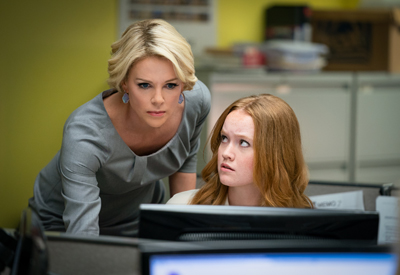 Randolph was in turn impressed by Robbie. "She captures that wide-eyed enthusiasm and core naivete of Kayla, which gets shaken as Kayla starts to make darker and darker choices," he observes.
Randolph was in turn impressed by Robbie. "She captures that wide-eyed enthusiasm and core naivete of Kayla, which gets shaken as Kayla starts to make darker and darker choices," he observes. It was also a pleasure for Robbie to take on a kind of real-life persona not often seen on screen: an evangelical millennial, and not in any way a stereotypical one. "I love that about Kayla," Robbie says. "It's great to have a Christian character who isn't being made fun of and isn't there for comic relief. There are a lot of different layers to Kayla and I find her reasons for being at Fox really moving because her main hope is to give a voice to people like her, people who she feels haven't been represented in the culture."
Robbie credits Roach with giving her the space to take Kayla from the heights of youthful ambition to a dark night of the soul. "He understands how to make a satirical moment effective, and how to find authentic drama, but he also has the utmost sensitivity," she says.
Lithgow On Ailes
To play Roger Ailes"and a man famously possessed of both a volcanic fury and a supremely personable charm"it was clear Bombshell was going to need an actor of unusual facility. Everyone involved was thrilled when John Lithgow joined the production. A two-time Oscar® nominee for The World According to Garp and Terms of Endearment, Lithgow is equally known for his award-winning television roles on 3rd Rock from the Sun, Dexter and most recently his Emmy® Award-winning take on another vastly intricate historical figure: Winston Churchill in Netflix's The Crown.
Ailes presented the kind of hugely challenging, multichromatic role Lithgow loves to sink his teeth into. The character was so full of contrasts. He was a man loved for his generosity, but who also installed closedcircuit cameras to spy on his employees. He was known for giving undiscovered talent a chance, but also for taking control of the length of their skirts. He was revered by some as a brilliant strategist and reviled by others for unravelling TV news into partisan echo chambers. If you crossed him, Ailes could be the most ruthless enemy. On the other hand, if he liked you a lot it could be equally perilous.
By his final days at Fox, Ailes was a divided soul. And that's what Lithgow embodies: an ailing commander who, with a mix of hubris and classical tragedy, still believes in his immense power even as his troops lose their loyalty. To start finding the character, Lithgow looked for documentation, but he notes that famous as he was, Ailes avoided being filmed. (Aisles passed away in May of 2017 at the age of 77.) "I found as much video as I could find but there's not a lot of it. Ailes was not a showman. He was a kind of ringmaster behind-the-scenes, but he didn't like to be seen."
Invaluable intel came from a long-time acquaintance of Lithgow's who had worked for Ailes. "I learned about what great company Roger could be, what an edgy, loud sense of humor he had," Lithgow says. "I learned about a whole different Roger Ailes then you've seen in the press. And just to know that was invaluable, to know there was something that captivated people and inspired their loyalty to him."
Part of Lithgow's multi-hued performance is Ailes's indignation at being accused by those he still believes adore and feel grateful to him. "I think Roger felt very proud of what he'd done for women. He thought he was on women's side. He says that in all sincerity in the movie: 'I gave these women their careers. How can anyone say I harmed them?' I think he truly believed that. But he was also a man in the grips of his own compulsions, which you see in the scene with Kayla."
Though the character was endlessly fascinating, a real draw for Lithgow is that Bombshell is decidedly not Ailes's story. "The real story here is the women who, following the lead of Gretchen Carlson, found the courage and the confidence to come forward and put an end to this poison."
The role also saw Lithgow donning considerable facial prosthetics, which he typically avoids. "I've always thought it extremely important for the audience to see every muscle in your face," he explains. But after meeting with Kazu Hiro, Lithgow was won over. "Kazu laid on about 6 pieces including jowls, a big double chin, a fake nose and earlobes. Then he spent another hour painting and painting to completely blend it with my own skin. He used this miraculous material, so the wrinkles in my face completely cohered with the wrinkles in the prosthetics. I was just astonished at how remarkably real I still looked."
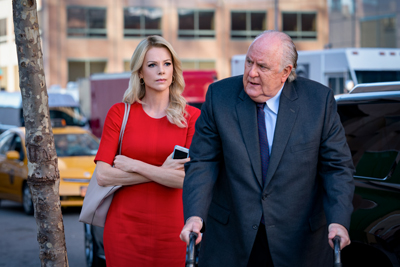 Perhaps the greatest thrill of the role was uniting with his fellow actors to tell a story everyone felt passionate about telling. "This was the best ensemble I've ever worked with," Lithgow says, despite his lengthy resumé. "These are wonderful moments as an actor when you feel like you're in something that's important, and might actually move the goalposts, while delighting people."
Perhaps the greatest thrill of the role was uniting with his fellow actors to tell a story everyone felt passionate about telling. "This was the best ensemble I've ever worked with," Lithgow says, despite his lengthy resumé. "These are wonderful moments as an actor when you feel like you're in something that's important, and might actually move the goalposts, while delighting people." For Roach, Lithgow was a revelation in the role. "You could portray Roger Ailes as a loud, predatory, obnoxious, raging narcissist. But the research showed that people loved Roger Ailes. Not just right-wing people, left-wing people also told me stories about how generous, warm and funny he could be. And what John was able to do was reveal the rougher side but to have this charming essence be the default," says the director. "John can do that. He can be disarming and also go to a very dark place."
Fox Family & Staffers
Supporting Bombshell's main cast is a large, highly accomplished ensemble, many stepping into the challenge of portraying real people. On the family side, they include Megyn Kelly's husband, Doug Brunt, played by Emmy®-winning writer, director and actor Mark Duplass (Wild Wild Country, Outstanding Documentary or Nonfiction Series (Executive Producer), 2018), who previously worked with Theron in Tully.
Duplass says the script hooked him because "it's about female empowerment, but from a different perspective than you've seen before. It's about three women trying to find that line in the modern world between asking what's best for me and my family and trying to stay true to their values."
As for Doug, Duplass loved that he plays second fiddle. "I enjoyed the idea that if this were the 1980s, Doug Brunt would be the wife role in the movie, but now we get to have such great and powerful female protagonists," Duplass muses. "Megyn and Doug are definitely a non-conventional conservative couple, where the gender roles are a bit reversed, with Doug the supportive spouse just trying to be there."
Another vital family portrait is that of Ailes's wife, newspaper publisher Beth Ailes, who came vociferously to his defense. She is portrayed by four-time Emmy® nominee Connie Britton, best known for her roles on "Friday Night Lights" and "Nashville." Beth's unwavering fealty intrigued Britton. Some Fox staffers also take on a personal significance. When Kayla moves from Gretchen Carlson's show to the higher rated "The O'Reilly Factor," she meets fictional character Jess Carr, sparking an unexpected if nebulous relationship, one that Robbie notes her character doesn't know how to reconcile with the rest of her life…so she doesn't. "Kayla in many ways disassociates from her sexuality," Robbie observes.
Taking the role is "Saturday Night Live" star Kate McKinnon, seen recently in Ghostbusters and The Spy Who Dumped Me. Here, McKinnon takes on a more shaded, dramatic role as the least likely of all Fox employees: both a closet liberal and gay. "According to firsthand accounts, you wouldn't want to be either of those at Fox News," McKinnon laughs.
Yet paradoxically, Jess thrives at Fox. "She has this job she's great at, but she just has to watch herself and stay under the radar with those two facts about herself," McKinnon explains. "When Kayla arrives, Jess sort of takes her under her wing and gives her the lay of the land at Fox in general as she sees it. They develop a friendship that is really based on humor, which is so refreshing."
Megyn Kelly's high-powered staff includes her increasingly anxious fictional executive producer, Gil Norman, played by comedic actor Rob Delaney, co-star of the popular Amazon series Catastrophe. A self-professed news junkie, Delaney could not resist the chance to drop into the behind-the-scenes at Fox News. "The most exciting part for me was the morally gray element of my character," Delaney says. "I found it exciting that Gil is really caught between two poles. One the one hand, he is absolutely trying to protect himself and his own career interests, but he also sees what is happening, and he knows it will come at a cost."
Taking the role of Kelly's fictional researcher Julia Clarke is Brigette Lundy-Paine, seen on Netflix's Atypical. This was an entirely different kind of role. "Young, neurotic, and new to the news scene" – that's how Lundy-Paine describes her character. "She's way over her head when all of this goes down. Working for Megyn is her a dream job, and she's immediately tossed into this insane election. So, it comes as a total shock to my character, just as it did to the nation, that Megyn was one of the attempted victims of Ailes."
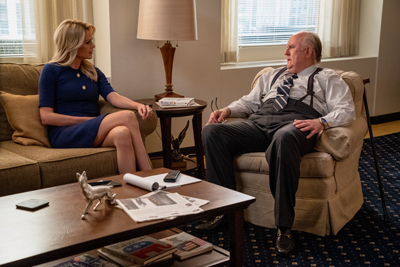 Rounding out Kelly's team is her fictional assistant and confidante, Lily Balin, played by Liv Hewson, who recently starred in Netflix's Santa Clarita Diet. Hewson says the way screenwriter Randolph was able to navigate the minefields of this tricky issue with such grace was magical. "It's a story that takes place at Fox News, but I think it really gets to how universal these experiences have been throughout history," says Hewson. "My character tries to underpin the things being said about Megyn with humor as much as possible. She often makes flippant quips, but really she is trying make it seem like it's all fine."
Rounding out Kelly's team is her fictional assistant and confidante, Lily Balin, played by Liv Hewson, who recently starred in Netflix's Santa Clarita Diet. Hewson says the way screenwriter Randolph was able to navigate the minefields of this tricky issue with such grace was magical. "It's a story that takes place at Fox News, but I think it really gets to how universal these experiences have been throughout history," says Hewson. "My character tries to underpin the things being said about Megyn with humor as much as possible. She often makes flippant quips, but really she is trying make it seem like it's all fine." Rudi Bakhtiar
Long before Gretchen Carlson brought her suit against Ailes, another Fox employee served as a warning sign as to how hard the company would fight against allegations. In 2007, news correspondent Rudi Bakhtiar lodged a complaint of sexual harassment against Fox News' DC bureau chief, Brian Wilson (who has publicly denied the charges). Bakhtiar was promptly fired by Fox and, pursuant to a settlement agreement, was prohibited from talking about what happened to her to anyone"a promise she kept until the 2016 scandal broke. Taking the role is Nazanin Boniadi, known for the Showtime series Homeland and Starz Network's Counterpart. As it turned out, Boniadi actually knows the real-life Bakhtiar, now a producer for Reuters. "How often does an actor get to play someone they know," Boniadi wonders. Her interest in the role went far beyond her personal relationship. "The story is so timely, but it's also timeless. Women have been going through this for hundreds of years, and the power dynamics behind it need to be explored."
Boniadi sees Bakhtiar as the bold forerunner who made the unseating of Roger Ailes possible. "She did it selflessly. She got nothing out of it. When I talked to Rudi about playing this role, she said, 'I hope you play it from the heart,' and I hope I have."
A parade of other hosts and anchors recognizable to Fox News viewers pop up throughout the story, from Judge Jeanine Pirro (Alanna Ubach) to Sean Hannity (Spencer Garrett), Ainsley Earhardt (Alice Eve), Geraldo Rivera (Tony Plana), Bret Baier (Michael Buie), Chris Wallace (Marc Evan Jackson), Greta Van Susteren (Anne Ramsay), Kimberly Guilfoyle (Bree Condon), Kevin Dorff (Bill O'Reilly), and Neil Cavuto (P.J. Byrne), among others.
The Murdochs
As the accusations against Ailes broke into the evening news, one person watching them closely was an even more powerful force than Ailes himself"the scrappy Australian media tycoon Rupert Murdoch, the veritable king of the Fox realm. Having inherited his father's newspaper business, Murdoch turned News Corporation into a vast empire of social and political influence, sparking a worldwide wave of right-wing populism.
It was Murdoch who took a chance on Ailes after he left NBC"and was handsomely rewarded as Ailes helped to build Fox News into the number one cable news channel in America. But in the film, Murdoch is faced with the stark reality that Ailes is suddenly becoming a liability. Tackling the outsized persona of Murdoch is legendary British actor Malcolm McDowell, whose work ranges from Kubrick's classic A Clockwork Orange to Nicholas Meyers' beloved sci-fi film Time After Time to recent roles in "Mozart in the Jungle" and "Entourage."
McDowell notes that he was not an obvious match with the Australian mogul, but he could not resist. "Murdoch is a titan and a terrific character to play," he says. "Of course, this is somebody I don't look or sound like, so it was about finding the essence of who Murdoch is, or at least his public persona." By the time Ailes was being openly accused, McDowell says that "Murdoch clearly knew that Roger had to go, that there was no way he could talk his way out of this one and that they had to show they weren't going to put up with any more shenanigans."
"But he and Roger were also good friends," McDowell continues, "and I think Rupert was extremely grateful to Roger for the incredible job he did at Fox, so it's a very interesting scene when it comes down to Rupert having to essentially fire the man he knows created this hugely successful news channel for him."
McDowell also credits his prosthetic chin for helping him to channel a man whose countenance was instantly recognizable. "They gave me this fantastic prosthesis that helped me to find that gravitas," McDowell notes. "It was kind of cool for me because I've never really worn prosthetics before."
Rounding out the powerful Murdoch family as Rupert's sons, Lachlan and James Murdoch, is a pair of actual Australian brothers: Ben ("The Good Place") and Josh Lawson (The ElevenO'Clock).
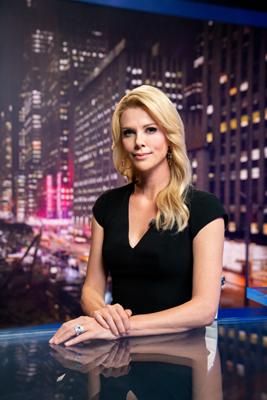 Fox Lawyers
Fox Lawyers While Fox stars and executives were the public face of the 2016 scandal, there was also a large role for Fox's large legal team. Playing Dianne Brandi, Fox News' general counsel and one of Ailes's lieutenants, is Amy Landecker, best known as Sarah Pfefferman on Transparent. Ultimately, for Landecker the story resonates because it's happening everywhere. "Whether you work at a Walmart or are an accountant, these dynamics are at play anywhere there's power and lack of power."
Landecker thought a lot about why many very smart women were ready to go to bat for Ailes's behavior. "I think there was something incredibly appealing about Roger as human being that built that loyalty. It's a complicated thing to play but that's what makes a role like this so fun. There's an operatic quality to the story, because the Fox world is at once alluring and sad, moving and controversial."
Ailes' personal attorney Susan Estrich, the law professor and frequent Fox News analyst, is played by Academy Award® winner Allison Janney. Janney won in 2017 for Best Supporting Actress, opposite Margot Robbie in I, Tonya and is beloved for her long-running role on "The West Wing." Although Estrich and Ailes had been on opposing sides of political campaigns for years, Ailes was there for her during an illness, and according to Janney, Estrich felt she owed him. "Susan's complicated because she is a feminist, a rape survivor, an author of books about sexual assault, and she's on the side of women's rights. Yet she makes the choice to represent Ailes," muses Janney. "I think she not only was repaying a debt, but she's also a really smart, tough woman, and if someone tells her no, she's going to say, oh yeah? Watch me!"
Roger Ailes's other personal attorney is former New York Mayor and United States Associate Attorney General Rudy Giuliani, portrayed by Richard Kind ("Mad About You," Argo) with the embellishment of prosthetic makeup effects.
Other Fox insiders seen in the film include Irena Briganti, Fox News' top publicist, played by Brooke Smith (The Silence of the Lambs); Bill Shine, who handles day-to-day management at Fox News, played by Mark Moses (Duck Phillips on "Mad Men"); and Bill O'Reilly, portrayed by former sketch performer and Emmy® Award-winning writer for "Late Night with Conan O'Brien" Kevin Dorff ("Brooklyn Nine-Nine").
Inside Fox's Chamber: Cinematography & Design
Bombshell drops audiences right into the chaotic center of a 24/7 cable news network, with all the energy, speed and crazy-making tension of the real thing. To achieve this total immersion, which gives audiences a grounded reality from which to reel with the comedy and dilemmas, Jay Roach brought in a highly decorated crew.
Leading the team is Oscar®-nominated cinematographer Barry Ackroyd, whose camerawork is among cinema's most recognizable. Renowned for his highly influential, kinetic take on natural realism, and his multi-camera shooting style, Ackroyd has been key to the in-the-moment feel of films ranging from Kathryn Bigelow's The Hurt Locker to Ken Loach's The Wind That Shakes The Barley, and Paul Greengrass's United 93 and Captain Phillips. He also shot The Big Short, which led Roach to give him a call.
"I've studied Barry's work for years because I love the subjective camera," says Roach. And I love his use of zoom because I think it mirrors how the human brain focuses in on what's most interesting. It's all instinct with Barry. He doesn't use a shot list, but I had total trust in his eye and especially his empathy with the performers. It seemed he could read their minds at times and know where they were going to go, even before they did. It was extraordinary to watch him work."
Ackroyd was captivated by the challenge of turning an everyday office space into a visually dynamic realm of competition, maneuvering and survival. "Most of the film takes place in what could be visually conventional, confining, interior spaces," he notes. "So, the idea was to instead make it feel exciting and alluring. Charles had written this incredible script that we all wanted to feel completely alive."
A big part of Ackroyd's trademark style is getting in close with characters and letting the camera react directly to the action rather than vice versa. To do that on Bombshell, he employed an array of Arri Alexa mini cameras, which allowed multiple operators (as he has done of all of his films, Ackroyd operated one of the cameras himself) to move through the scene. "Shooting in an office, one camera can only respond to what's in front of it," Ackroyd explains. "You can't create an energy over and above what exists. So, we used multiple cameras–for instance, one in a closet, one in a doorway and one by a wall. That gives the director and editor the chance to choose the best way to look at the world at any one point."
He paired the Arri Alexa minis with Angenieux lenses, popular with documentarians. "As a DP, most of what I can control comes from the lenses, and with lenses I always look for a kind of authenticity," Ackroyd says. "I like zoom lenses. I like the way they direct your eye and your emotions, how you can push in on a zoom and lose the background, concentrating the mind. I think that's very much how the human eye works."
Unusually in this film, Ackroyd was able to utilize his documentary-style approach. As a way of introducing the Fox News offices, Charlize Theron as Megyn Kelly leads an on-camera tour through the building, with Theron speaking directly to the camera. "It becomes a great way of introducing the building, the place and the character," says Ackroyd.
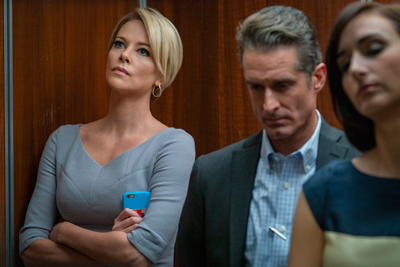 Working for the first time with Roach, Ackroyd felt simpatico with the director. "Our focus puller had a great way of describing this experience: it felt like surfing. It had that kind of flow," he says. "That has a lot to do with Jay's passion."
Working for the first time with Roach, Ackroyd felt simpatico with the director. "Our focus puller had a great way of describing this experience: it felt like surfing. It had that kind of flow," he says. "That has a lot to do with Jay's passion." Ackroyd also credits production designer Mark Ricker for creating vastly detailed, life-like sets for his team to explore. Ricker, who worked with Roach on Trumbo and All The Way, relished creating Bombshell's more then 100 sets. "At first I thought it's just an office film, but then, I began to look at it as an epic design puzzle," Ricker recalls. "I saw the exciting challenge was to create a unique personality for the Fox News building and fit together all these different pieces within it to create the big picture."
Without an invitation into the real Fox News, Ricker re-created most of the interiors"including the newsroom itself"inside another media giant's offices: the recently vacated LA Times building in downtown
Los Angeles. "Our location manager, Chris Baugh, first thought of the LA Times building," says Ricker. "It had everything going for it, especially in terms of being able to do everything under one roof."
Still, it would take a demanding effort to transform that building's circa-1935 Art Deco look into Fox's sleek Manhattan skyscraper. It began with scoping out inside sources, so Ricker could get the lay of the land. He and his team also scoured the internet for images from rogue posts on Facebook and Twitter.
One of Ricker's favorite sets was the famed Fox News basement, the nexus of the operation. "It was described to me as being three football fields worth of cubicles"which they call pods"full of production assistants, junior producers, editing bays and the assignment desk. From the evidence I saw in archival photographs it was party central down there with stuffed animals, blown up balloons, even party lights. The young staff just threw their personalities into this windowless space underneath the bowels of New York to make it as palatable as they could."
In stark contrast to the warren-like frenzy of the basement is the 17th floor, where Megyn Kelly and all the powerhouse anchors have their lavish offices bespeaking their top-of-the-food-chain position. Lining the walls of the executive offices is artwork by Georgia-based artist Steve Penley, whose presidential portraits and politically themed landscapes have become decorative must-haves for many GOP leaders. From there, each individual character's persona led that way. "We wanted each office to have the character of its occupant peeking through, using as much research as we could," says Ricker.
There were enough photographs of Kelly's former office that Ricker was able to glean 360 degrees of detail. "Her desk, her chaise, her shoe racks"it's all there," muses Ricker. "Hats off to our set decorator Ellen Brill who created something really spot on."
The 2nd floor is the realm of Ailes himself, shared with the network's legal and PR offices. "There was a 'Hollywood Reporter' article from 2015 that had some very good portraits of Roger's office, so that was a good starting point," says Ricker. "And we knew certain things that would be in there"a brick that was given to him from Osama Bin Laden's compound and a helmet signed by Jim Brown. We also knew that Roger had a special door installed, an extra layer of security that sets his office apart."
Finally, all roads at Fox begin and end on the 8th floor, where the Murdochs hold sway. "The 8th floor is command central," Ricker describes. "Stylistically, it's very, very elegant, full of glass and light." The sets for both Megyn Kelly's "The Kelly File," and Gretchen Carlson's "The Real Story" were built at West Hollywood's Quixote Studios. Other locations include USC's Galen Center sports arena, which doubled for Cleveland's Quicken Loans Arena, site of both the Republican Presidential Primary Debate and Republican National Convention; the iconic Malibu Pier, which stands in for the Jersey Shore restaurant where Megyn Kelly is accosted by angry tourists while eating with her family; and a private 8000-square-foot French Country Estate near Malibu's Zuma Beach portraying the Ailes Mansion in Bergen County, New Jersey.
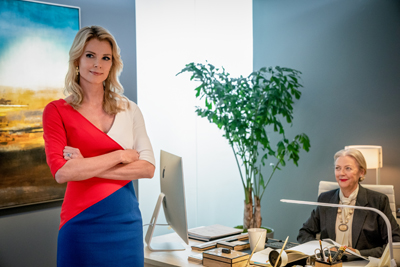 Costumes, Makeup, Prosthetics And Music
Costumes, Makeup, Prosthetics And Music To create the instantly familiar Fox News anchor look"full of slim-fitting, leg-baring, red, white and blue dresses and high heels--Roach brought in a film legend: the twelve-time nominated, four-time Oscar®- winning costume designer Colleen Atwood (Chicago, 2002; MemoirsofaGeisha, 2005; Alicein Wonderland, 2010; Fantastic Beasts and Where to Find Them,2016).
The sheer scope of the film, which involved the creation of some 500 distinct costumes, was a big draw for Atwood who has long thrived on epic jobs. "With more than 100 characters, I knew it would be a fun and interesting process," she says. "Some of the characters may only have brief moments on screen, but they all are important to putting together the full story."
For Roach, the chance to work with Atwood was a thrill. "Colleen is a master," says Roach. "She has done all this incredible fantasy character design work, and this was different because it's capturing a workaday look. But once you really dig into how key the Fox look was to the network and how strictly it was enforced it's a big part of the storytelling and Colleen completely engaged with that idea."
Atwood was acutely aware of the so-called "news uniform" style many of the Fox News women exhibited throughout the Roger Ailes era. "I don't think it's a look so much as a standard set for them, which was tannish skin color, blonde hair, bold colors, tight-fitting silhouettes and a lot of leg," she observes. "Then some of the network's stars did their own riff on it. So, for example, Megyn brought a chic fashion sense to that aesthetic. But they're all definitely polished in a familiar way."
She has a chance to reveal more about the characters in their off-hours. "Newscasters don't walk around all day in bright red dresses in their real life," Atwood points out. "We were able to bring out more facets of their characters in their off-duty clothes. I worked closely with Charlize, Nicole and Margot, to figure out how they each saw their characters beyond their roles at the network."
Kidman's Gretchen Carlson changes her look after leaving Fox. "Her look softens from her very recognizable on-air persona and takes on a more approachable feeling," notes Atwood. "She's very vulnerable in this period of time, so I used a lot of soft tones for Gretchen."
For Megyn Kelly, Atwood was intrigued by the idea that she was not only a powerful star but also a mother with a whole other life. "She's got a family, and I thought it was important that we see that more relaxed side of her," Atwood explains. "She's a little bit more casual outside the office, but still very chic, because in every photograph of Megyn I've seen, she's always pulled together."
Atwood had more leeway with fictional Kayla, since she was creating her look from scratch. "She is someone who decides to come to the table and play the game, but that game kind of breaks her. So, we take her from softer, purer, Southern kinds of colors, into a more brittle, cosmopolitan style."
Once on the set, the pace of costume changes was grueling but exhilarating. "Every day we might have five or six looks for the main characters, so just maintaining it all was a huge challenge," says Atwood. The costumers also worked to incorporate full-body prosthetics for some of the cast, especially Kidman and Lithgow, who have extensive enhancements. "Nicole has a very different body, so we built a whole-body suit for her to give her bigger hips and a bigger bust, even trying to make her look a little bit shorter. John Lithgow also wears a [prosthetic] suit which helps bring the character to life."
Morphing well-known stars into other well-known stars also required the talents of a highly skilled team of makeup and hair artists. Supervising the team was makeup department head Vivian Baker ("Grey Gardens," Lemony Snicket's A Series of Unfortunate Events), while Oscar® winner Kazu Hiro (the renowned sculptor who transformed Gary Oldman into Winston Churchill for Darkest Hour) was in charge of the prosthetic makeup.
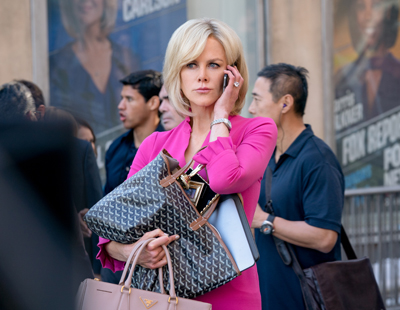 Baker loved collaborating with Hiro and was constantly amazed by how he can create prosthetics that look so human that you can't tell where the prosthetics end and real skin begins. "Kazu sets a really high bar," says Baker. "He loves to focus in on the details, and I do too, and we were able to work together so it looked everything was done by the same hands. It was quite exciting and very fun."
Baker loved collaborating with Hiro and was constantly amazed by how he can create prosthetics that look so human that you can't tell where the prosthetics end and real skin begins. "Kazu sets a really high bar," says Baker. "He loves to focus in on the details, and I do too, and we were able to work together so it looked everything was done by the same hands. It was quite exciting and very fun." For those actors who needed physical transformation"not just Kidman, Theron and Lithgow but also McDowell as Murdoch, Richard Kind as Rudy Giuliani and Tony Plano as Geraldo Rivera, to name a few" the process began with 3D facial scans and plaster casts. From there, Hiro molded silicon appliances to match the real-life counterparts. Of the leads, Kidman had the most extensive facial prostheses, including eyelids, nose tip, chin, and jaw pieces. Theron had more subtle prosthetics but also wore contact lenses for Kelly's darker blue eye tint. Lithgow wore prosthetic cheeks, neck, nose and earlobes.
Hiro says subtlety was the key to his work. "These are famous actors, and everybody knows what they look like, so the idea was that we would add just a little hint of the person they're portraying–while making it light enough for them to move their face," he says. "It helps the actors go deeper into their characters and it helps the audience to immerse themselves into the story."
Continues Hiro: "You never want the prosthetics to feel like an obstacle to the actors. So, the hardest part is to figure out how to make them feel like this person"for Charlize to feel like Megyn and Nicole to feel like Gretchen"but also to feel like they have nothing that is restricting their face."
The actors were deeply appreciative of his sensitivity to their craft. Says Theron of Hiro: "He has the same kind of values that I have about the work, which is that he doesn't want the audience to see the mechanics of what he's doing. He's going for something pure."
Once Hiro applied the prosthetics, Baker followed with the beauty makeup. "It wasn't just about putting on lashes and lipstick. We were doing things like erasing their eyebrows and painting them in an entirely different place," Baker notes. "It's the kind of thing makeup artists really love to do."
Baker watched a lot of archival footage to dissect the "Fox face." "They're known for flawless skin," she observes. "Their lips are usually shiny, but not dark red, and the eyes have thick false lashes. In fact, we found we needed to stack three or four sets of lashes just to get the look we were going for!"
The only main character who wears no prosthetics, Margot Robbie's Kayla, was especially fun for Baker. "Kayla is the one character who has a true physical arc where her look changes in the course of the story," she notes. "Kayla comes in kind of wide-eyed, with a simple, everyday look that doesn't quite have finesse yet. But as she climbs the ranks, and as she pays the costs of that, her look changes. And I think to some it may be beautiful and to others it may seem too much."
Hair, especially the golden blonde coif for female anchors and correspondents, is equally a staple of the Fox aesthetic. Baker was thrilled to reunite with hair designer Anne Morgan (The Artist, Gangs of New York, Walk the Line) who also worked with Jay Roach on All The Way. Morgan put the finishing touches on the characters, utilizing more than 45 custom wigs.
Watching hours of archived Fox shows, Morgan saw an evolution from the Gretchen Carlson era to the Megyn Kelly era. "Gretchen had that very stylized Fox look, with lots and lots and lots of hair," she observes. "But when Megyn became the star anchor, she took more risks."
Morgan was especially fascinated by Kelly's dramatic 2016 crop right before the Republican debates. "I wished I could have had a conversation with her and ask why did you cut your hair? As a hairdresser for 30 years, my feeling was that this is a woman who just wanted to be taken seriously. It made a statement that she was taking control of herself and how she wanted to be perceived."
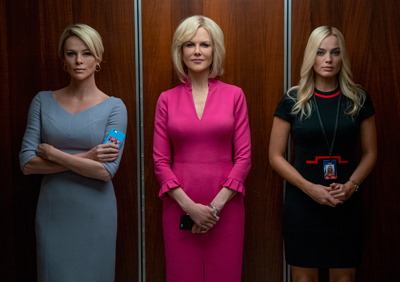 Margot Robbie as Kayla was also a lot of fun for Morgan. "We take her from a sweet, innocent Florida weathergirl to a Fox look I call the 'soft serve,'" Morgan describes. "She's like an ice cream cone all whipped up with so much fake hair."
Margot Robbie as Kayla was also a lot of fun for Morgan. "We take her from a sweet, innocent Florida weathergirl to a Fox look I call the 'soft serve,'" Morgan describes. "She's like an ice cream cone all whipped up with so much fake hair." Beyond the main characters there was a remarkable range of hairstyles to explore. "We really ran the gamut from old school Roger Ailes, Bill Shine and Rudy Giuliani to women newscasters like Kimberly Guilfoyle, Ainsley Earhardt and Alisyn Camerota, to their male counterparts like Bill O'Reilly, Sean Hannity, Chris Wallace and Bret Baier. When we had them all together in the room, it was fantastic to see. There was a feeling of paying respect to the real people while never crossing the line into caricature."
When production wrapped, the intensity only continued for Roach, who entered the editing room with his long-time editor Jon Poll and additional editor Nina Kawasaki. "Jon is such a great selector of performance," says Roach. "So often I would find that he chose the exact moment I most was looking for. He made the feel and pace of the movie that much richer and faster."
As the film was finding its dynamic structure, Roach was finalizing the score with composer Theodore Shapiro, who had worked with him on Dinner for Schmucks. This was a completely different challenge. Echoing the risks of the writing, Shapiro and Roach went for an unconventional score that incorporates women's voices, like a Greek chorus commentating on the events.
"Teddy had the idea of using instrumentation that is nearly all voices," explains Roach. "It's really playing with the idea of women both as individuals and as a unified force. I'm grateful to Teddy for creating such amazing music for us."
The final touch was Regina Spektor's original end credits song "One Little Soldier." Roach was taken aback when he first heard the song. "I said, Regina, you've channeled the whole movie--how did you find that? And she said, I just remembered what you said mattered most was connecting to the idea of a lone woman stepping forward to take on this whole institution."
Indeed, that idea"simple but very big"became the inspiration for nearly every element of the film. "I think that we all were thinking about the fact that a lot of women are in this situation right now where if they step up, they don't know if anyone will support them," says Roach.
For Roach, there is a lot of hope that more support and more change is coming. "There's still so much to be talked about, and this film is just part of the conversation," he says. "But you never know"as this story shows, sometimes it only takes one person speaking out to start something."
Bombshell
Release Date: January 16th, 2020
MORE



